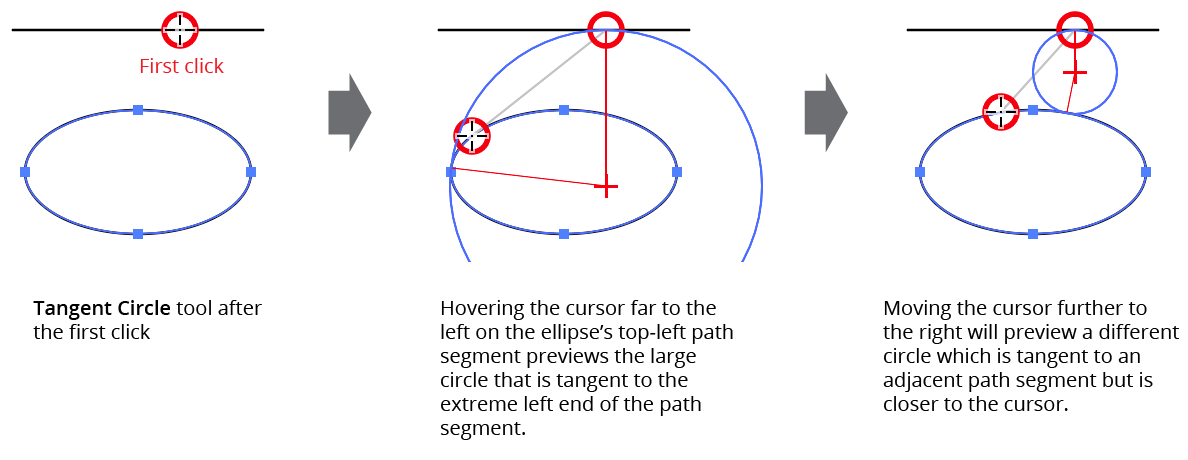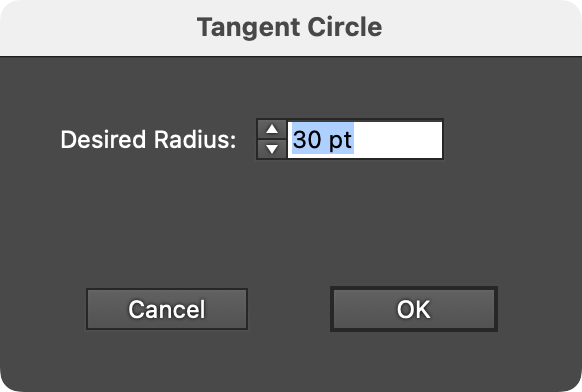 Tangent Circle Tool Operation
Tangent Circle Tool Operation
As the Tangent Circle tool has several keypresses which can add or change its functionality, we suggest installing the free Astute Graphics plugin Astute Buddy, which creates a panel that dynamically updates to inform you of the various keys which can be pressed in the tool’s current context.
In the general case, there are an infinite number of circles which could be drawn tangent to two path segments, differing in their location and radii. Therefore, some method must be used to locate the desired circle. The Tangent Circle tool has two different locate modes. In “Anchored Locate Mode,” the circle is constrained to pass through the point at which the first path segment is clicked. In “Radius Locate Mode,” the circle is constrained to a specific radius. In either mode, Tangent Circle provides an option to adjust the radius of the circle after its creation.
Anchored Locate Mode
In this mode, the tool is used by clicking on one path segment, and then clicking on a second. The paths on which the segments lie do not need to be selected. A circle is then created (when possible) that passes through the first point (and is tangent to the first path segment at that point) and also is tangent to the second path segment.

Tangent Circle Tool Basic Example
The Tangent Circle tool will actually also consider path segments that are adjacent to the second one, and will prefer circles that touch them if their tangent point is closer to the cursor than those that touch the actual segment that the cursor is over:

Tangent Circle Tool Closest Example
The second segment may be on the same path as the first segment:

Tangent Circle Tool Same Path Example
If no anchored circle can be located, annotation text adjacent to the cursor will indicate this.
Radius Locate Mode
By holding down Shift when hovering over and clicking on the second path segment, Radius Locate Mode is used, whereby the tool locates the doubly-tangent circle closest to the clicked point anywhere along the path(s) with the default radius specified in the preferences.

Tangent Circle Tool Radius Locate Mode
If no circle with the specified radius can be located, annotation text adjacent to the cursor will indicate this.
Adjusting Circle Radius Numerically
If the tool preference Ask For Circle Radius is enabled, then regardless of which mode was used to create the circle, a dialog will be shown after the mouse button is released allowing you to change the radius. However, if the radius was adjusted by dragging (see below), then the dialog will not be shown.

Tangent Circle Tool Radius Dialog
While the dialog is up, each change to the radius value will re-preview the circle in its new position. If the radius is changed to a value for which no circle can be found, an alert message will be displayed. If the dialog is cancelled, no circle will be created.

Tangent Circle Tool Numerically Adjusting Radius
Adjusting Circle Radius by Dragging
If, after clicking on the second path segment, the mouse button is not immediately released but a drag is started instead, then the Tangent Circle tool will dynamically attempt to locate a circle with a radius equal to the current distance between the start of the drag and the end of the drag (visualized as a gray line and numerically annotated next to the cursor). Releasing the mouse button creates the circle, if found.

Tangent Circle Tool Adjust Radius by Dragging
Several modifier keys may be pressed while dragging to adjust the circle radius:
Shift: Constrains the radius value to “nice” values, dependent on the current zoom level and units. For example, at 200% zoom, the radius is constrained to multiples of 2 pt or 0.5 mm.
Option/Alt: Toggles the tool preference Add Points to Existing Paths (see Tangent Circle: Preferences).
Command/Ctrl: Enables Slow-Drag, in which the cursor movement is “geared down” by a factor of ten for more precise control of the radius change.
